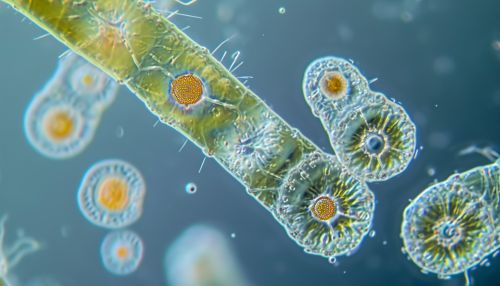Euglenozoa
Overview
Euglenozoa is a large group of flagellate excavates. This group is known for its distinctive features, such as the presence of a pellicle made up of proteinaceous strips underneath the cell membrane, and the unique form of mitosis observed in their nuclei. Euglenozoa includes a variety of free-living and parasitic forms, and species that can perform photosynthesis or feed heterotrophically.


Classification
Euglenozoa is classified under the supergroup Excavata, which is one of the major groups of eukaryotes. The group is further divided into three main subgroups: Euglenids, Kinetoplastids, and Diplonemids. Each of these subgroups exhibits a unique set of characteristics and ecological roles.
Euglenids
Euglenids are a diverse group of single-celled organisms characterized by the presence of a flexible pellicle, which allows them to change shape. Many euglenids, such as Euglena viridis, are photosynthetic and contain chloroplasts for the production of food through photosynthesis. However, some euglenids are heterotrophic and feed on organic matter in their environment.
Kinetoplastids
Kinetoplastids are known for their single, large mitochondrion that contains a unique structure called a kinetoplast. This group includes several important parasites, such as Trypanosoma brucei, which causes African sleeping sickness, and Leishmania spp., which cause leishmaniasis.
Diplonemids
Diplonemids are a group of marine flagellates that are often overlooked due to their small size and the difficulty in culturing them. However, they are considered to be one of the most abundant groups of eukaryotes in the ocean.
Morphology
Euglenozoans exhibit a wide range of morphological features, but all share some common characteristics. They have one or two flagella that emerge from a pocket at the front of the cell. The flagella are used for locomotion and are often adorned with distinctive hairs or rods. The cell surface is covered by a pellicle, which provides structural support and allows the cell to change shape.
Reproduction
Euglenozoans reproduce asexually through binary fission, a process in which the parent cell divides into two identical daughter cells. During this process, the nucleus undergoes a unique form of closed mitosis, where the nuclear envelope remains intact throughout the process.
Ecology
Euglenozoans are found in a wide range of habitats, from freshwater to marine environments, and from the polar regions to the tropics. They play important roles in the ecosystem as primary producers, consumers, and in some cases, as parasites.
Evolution
The Euglenozoa group is thought to have evolved from a common ancestor that was a phagotrophic predator. The ability to perform photosynthesis evolved later, likely as a result of an endosymbiotic event where a eukaryotic alga was engulfed and retained by a euglenozoan ancestor.
Medical and Economic Importance
Several species of kinetoplastids are of medical and economic importance due to their role as parasites. Diseases caused by these parasites, such as African sleeping sickness and leishmaniasis, have a significant impact on human health in many parts of the world.
